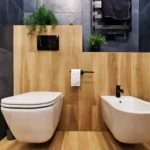Bidets have become increasingly popular for their hygienic benefits and cost-effectiveness. However, the installation process can sometimes present a few challenges. Fortunately, most of these issues can be resolved with a bit of know-how.
This blog post will walk you through some common troubleshooting tips during bidet installation to ensure a smooth setup.

Troubleshooting Tips for Bidet Installation
Removing Your Existing Toilet Seat
The first step in the bidet installation process is removing your existing toilet seat. If you encounter difficulty due to rusted or stubborn bolts, a penetrating oil such as WD-40 can help to loosen them. If this doesn’t work, you may need to cut through the bolts with a hacksaw, but be sure to protect the toilet bowl with masking tape to avoid any scratches.

Low Water Pressure
If the water pressure from your bidet seems inadequate, there are several possible causes. Firstly, ensure that the water supply valve is fully open. If the pressure remains low, inspect your bidet’s nozzle for any potential blockages. In other cases, a faulty T-valve or a kink in the hose could be responsible. Replacing these parts often resolves the issue.

Leakages
Leaks are a common issue during bidet installation. If you notice a leak, identify its source. If it’s coming from the connection between the bidet and the water supply, check the attachment of the T-valve and tighten if necessary. If the leak persists, consider using plumber’s tape to achieve a tighter seal. Be cautious not to overtighten as this could damage the threads.

Nozzle Spray Issues
If the nozzle of your bidet isn’t spraying correctly, it may be clogged. A gentle cleaning with a soft toothbrush and vinegar can often fix this. If the problem continues, refer to your bidet’s manual or contact the manufacturer’s customer service.

Electrical Problems
For electric bidets, electrical issues can crop up. Ensure that your bathroom outlet is GFCI-protected to prevent potential shock hazards. If your bidet isn’t powering on, check that the power cord is correctly plugged in and that there are no tripped breakers.

Conclusion
While installing a bidet can seem daunting, understanding how to troubleshoot common issues can help streamline the process. Always refer to the manufacturer’s instructions and don’t hesitate to seek professional assistance if you’re unsure about any steps.
With these troubleshooting tips in hand, you’ll be well-equipped to enjoy the benefits of a bidet in your home. Safety should always be your priority. If you’re uncomfortable dealing with plumbing or electrical tasks, it’s advisable to hire a professional to install your bidet.
Click Here for more helpful articles on Bidet Attachments.





